The Best Way to Make Acorn Flour
September 26, 2013 | Updated February 12, 2021
As an Amazon Associate I earn from qualifying purchases.
There is really only one good way to make quality acorn flour: Cold leaching.
Leaching, as is pulling something out. In this case, that something is tannin, which is present in all acorns. Different acorns have different levels of tannins, but in general oaks of the red oak family have more, the white oak family less. One, the Emory oak of the Sonoran Desert, has almost none at all.
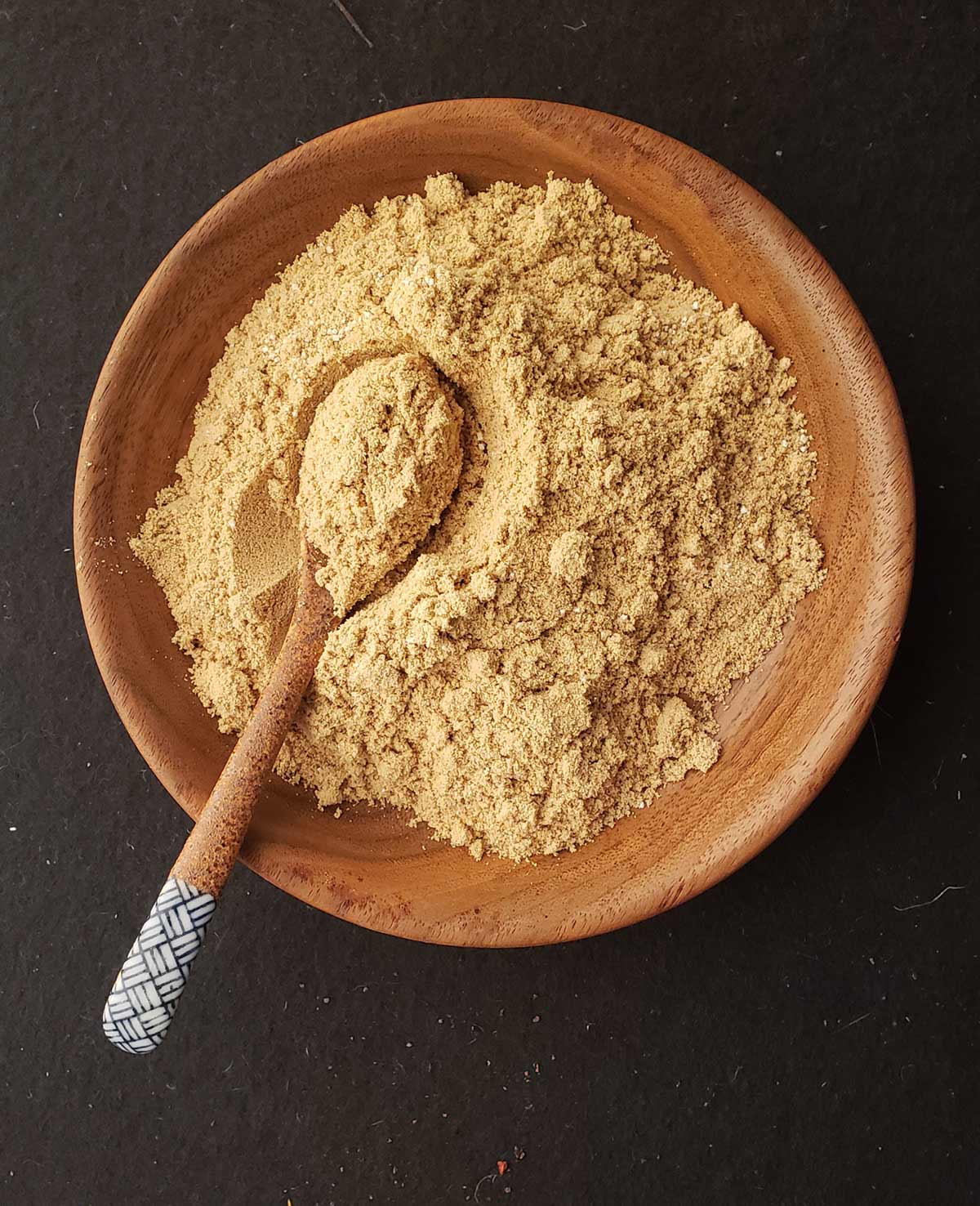
Before I go much further, let me answer the question in many of your minds: Why the heck would I bother making flour from acorns? First, flavor. It’s a lot like chestnut flour: Nutty, a little sweet and just generally interesting. Second, nutrition. Acorns vary in nutrition. Some are very starchy, some oily, a few high in protein. Third, it’s just kinda fun to make something useful and tasty out of something many of us mistakenly believe is poisonous.
In my original post about eating acorns, I recommended the boiling water method of leaching out all those bitter tannins. This works fine, and is comparatively fast; you can have a batch of acorns leached in the time it takes to watch a football game, which is about three hours for those of you who have never actually watched a football game.
The problem? The resulting acorn flour is very dark, and the boiling process destroys a key starch in the acorns — a starch that acts a lot like gluten in wheat, i.e., it helps the acorn flour stick to itself, or to thicken gravy or a roux.
I have found myself using acorn flour mostly for making roux, coating meats or as a flour additive in baked goods, tortillas, and pasta. So that starch is pretty important to me.
Cold leaching solves this problem. It preserves the starches and, when dried properly, keeps the flour lighter — closer to whole wheat than that dark chocolate brown you can get with boiling water-leached flour. The tradeoff is time. It takes at least a few days to “clean” your flour, and it can take more than a week.
But it’s easy time. All you need to do is tend your flour once or twice a day. Here’s how to go about it.
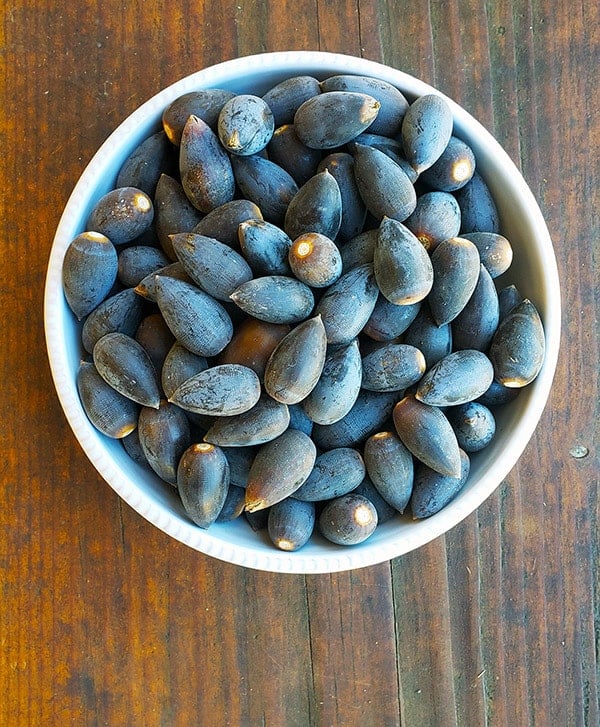
Start with acorns. I know, obvious, right? But know that they need not be fresh. Last summer I made a batch of flour from some red oak acorns I’d picked the previous October. I’d laid them out in a shallow layer in a large tray and just let them dry out. When it came time to crack the shells, it was so much easier than with fresh acorns; fresh acorn shells are pliable, and don’t crack like, say, a hazelnut’s shell.
You will need to soak your shucked acorns in water overnight, though — and it’s the devil to get the papery skins off dried red oak acorns. Those skins darken the flour and are very tannic.
I don’t really bother working too hard at removing the skins, but there is a trick that helps get them off (the skins are called the “test”): Freeze your acorns fresh. When they thaw and you crack them, the skin comes off a lot easier. The problem is storage. Acorns are bulky and can take up a lot of space in your freezer. But hey, if you want that skin off, it will help.
Regardless, shuck your acorns into water. This helps prevent them from oxidizing. I find that if I leave acorn nutmeats out, they turn brown over time. If they are fresh acorns, the papery skins should slip right off once the acorn has soaked a bit.
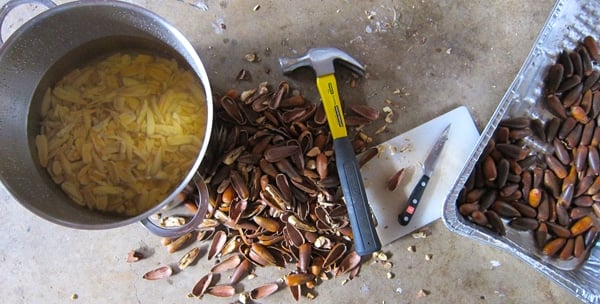
If you have some acorns with worm-eaten bits, you can cut off the bad part if you want to and toss the good part into the bucket of water.
Once your acorns are all shucked, put enough of them to fill a blender or food processor (use a food processor if your blender isn’t too strong) up about 1/3 of the way. Add enough water to fill the bowl of the processor or blender up halfway. Buzz the crap out of it until you get what looks like a coffee milkshake. Play a mean trick on your friends by pouring them some, and watch the hilarity.
Now, you will need a large container. The absolute perfect container to my mind are those big glass jars you get at the Asian market to make kimchi. You can buy gallon glass jars online or in many hardware stores for about $15. Pour the “coffee milk shake” into the big jar and keep adding more until you have about 50 percent ground acorns and 50 percent water. Cap the jar.
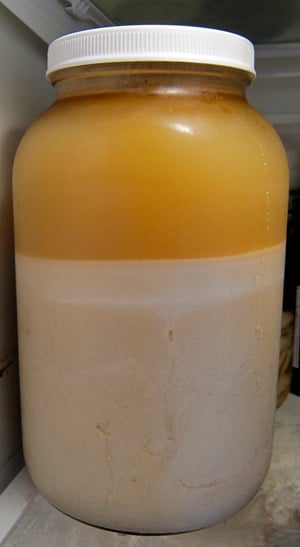
Put the jar into the fridge or just a cool place — it must be below 75°F or the flour will ferment — and walk away. Each morning, pour off the water, being careful to not lose too much of your acorn flour. Refill the jar, cap it and shake the hell out of it, turning it upside down to make sure all the acorn flour is suspended in the water. Repeat as necessary.
Now, there is an added tip you can do to make an even higher quality acorn flour: Strain the water every day through cheesecloth. Why? Look at the picture above: See the top layer that’s lighter in color? It’s acorn fat and starch.
It’s so light some will pour off every day as you change the water. Straining through cheesecloth preserves this fat and starch and will make your flour even richer and tastier. Do this and you will be rewarded with flavor later.
You know your acorn flour is ready when you roll some around in your mouth and it tastes really bland. Not tannic or bitter at all. Roasting can eliminate a little bit of tannin, but we’re not roasting in this case, so you want the flour to be as “clean” as possible.
For California Valley oak acorns, Eastern white oak acorns or other “sweet” acorns, this process could take as few as three days. But 5 days is more normal. California black and blue oaks take about a week. And Eastern red oak acorns? They took 10 days. When in doubt, go another day. You can’t hurt the flour by leaching a few extra days.
Now you have a bunch of soaking wet flour. First thing you will need is cheesecloth. Any supermarket will have it, but I have taken to using real cheesecloth, i.e., cloth actually used in cheesemaking. You can buy real cheesecloth online or in specialty shops.
Line a fine-mesh strainer with some cheesecloth and set it over the sink. Pour the water in the jar through it, catching all the flour.
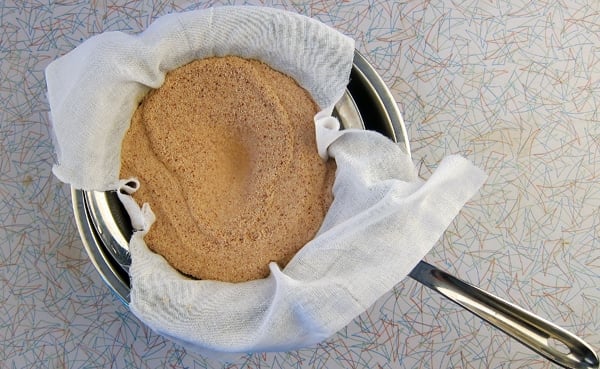
Squeeze the cloth tight around the flour to extract as much water as possible. This is why I use real cheesecloth — the cheap stuff at most supermarkets is too porous and thin to do the job very well, forcing you to squeeze less and spend more time drying — and the longer the drying time, the darker the flour. You will be left with what looks a lot like a ball of clay.
Tip: Let the water in the bowl settle for 1 hour. Carefully pour off the water and you will see a layer of what looks like beige house paint or melted coffee ice cream. This is acorn starch and fat. Use a spatula to scrape it into the container you are drying your acorns in.
Now you need to really dry your flour, unless you plan on making something with it right away. I almost never do this.
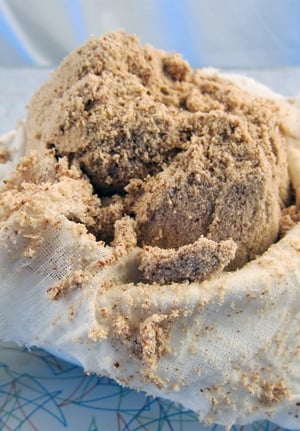
Spread your wet flour on a baking sheet, or on a solid dehydrator tray; the trays you use for fruit leather. I prefer the dehydrator because I can dry at a lower temperature. Or, if you do this in summer, you can dry outdoors or in a hot garage.
Dry at as low a temperature as you can. I use a dehydrator set at 95°F. Check in on your flour every few hours, turning it over so it dries evenly. This can take anywhere from an hour to a day. You want the flour to be dead dry. No moisture.
You are almost there. You now have what is essentially acorn “corn meal,” a gritty, coarse “flour” you can use to make polenta with; it’s pretty good, actually. But to make real flour you need to grind it one more time.
To turn your acorn polenta into acorn flour, grind the dried meal in a spice grinder, coffee grinder, or, best yet, a Vitamix fitted with dry blades. This is what I use, and it is worth every penny.
If you have a flour sifter this is a good time to break it out. Grind and sift into a clean bowl until you have nothing but pure, powdery goodness. A typical coffee grinder will require about 35 seconds of grinding to get there, my Vitamix takes only 15 seconds.
Your acorn flour is mildly fragile, especially if you are dealing with high fat acorns, like blue oaks, live oaks and red oaks. I store mine in quart Mason jars in the fridge or freezer. Stored this way, the flour will last for several years — which is good, because oaks don’t drop huge amounts of acorns every year.
Does all this sound like a lot of work? Well, I won’t lie to you: It is. And like I said, this process makes the highest quality acorn flour possible. There are easier ways, but the quality of the flour is inferior. This will make you quite aware about how we take regular wheat flour for granted. Do this and I can guarantee you will not be tossing around acorn flour the way you would with all-purpose. It’s too precious.
How to Make Acorn Flour
Equipment
- Cheesecloth
- A large jar
- Blender
Ingredients
- 3 pounds acorns
- Water
Instructions
- Start by shelling your acorns into a bowl of cool water. This will take about an hour, more or less. I typically do it while watching television. Putting the shells in water immediately will prevent them from oxidizing.
- Once you have all the acorn meats shelled (a little of the brown skin, called the test, is OK), puree them with water in the blender. Pour this into your large jar and set in a cool place, cooler than about 60°F. I will often refrigerate it. Temperatures too warm will cause it to ferment.
- Every day, up to twice a day, carefully pour off the water and replace it. As an added, but optional step, you can pour the last of each day's water -- the stuff with the most fine sediment in it -- into a baking sheet and let the water evaporate from it. What's left is pure acorn starch, which you can use exactly like corn starch.
- After about four or five days, taste the meal. It should be bland, not bitter. If it is still bitter, keep changing the water until it's not. Each species of acorn will need different leaching times.
- When the wet meal is ready, move it to a strainer lined with cheesecloth. Strain out as much water as possible. In this step, you really do want to capture this last water because it is loaded with starch. Let that water evaporate from a baking sheet.
- Lay out your wet acorn meal to dry. I use a dehydrator set at 95°F. Shoot for conditions like that. An oven is too hot and will turn the flour dark brown.
- When the meal is completely dry, add it and any chunks of acorn starch to a spice grinder or blender and buzz until completely fine, like wheat flour. Store in a jar in the fridge or freezer, so the acorn fats don't go rancid. It will keep this way a year or more.
Notes
Nutrition information is automatically calculated, so should only be used as an approximation.


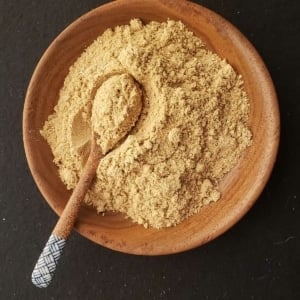



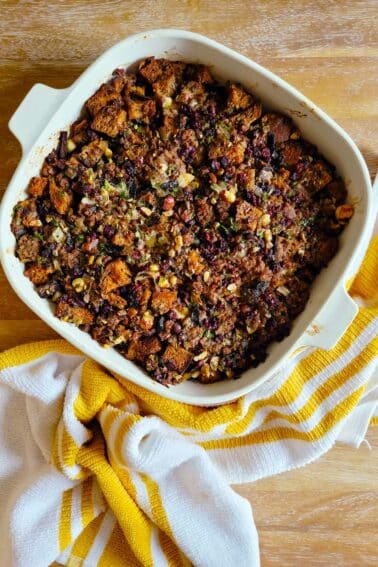
I live in Northern California and I did this last year collecting mostly Coast Live Oaks. The first time I tried it, I just threw acorns in a five gallon bucket, then brought them home to sort. When I got home, that is when I noticed that 80% of them had worms in them. I tried shelling them and just saving the good parts and it took hours to just get a quart. So I went out again with a hammer and some Felco pruning shears. The hammer was tedious but the Felcos cut the the acorns in half easily, so I did the sorting in the field. This time I got 3 gallons of shelled, halved acorns in about 3 hours or about the same time it took me to get a quart my first try. The added benefit was the acorns were already halved and when I got home(sorting already done) all I had to do was add water to the bucket to start the leaching process. It took 12 days of leaching. I would also recommend nylon paint strainers instead of cheese cloth. They are super durable and ultra fine and you can squeeze the heck out of them without destroying the fabric weave. Somebody suggested that I could load up a couple of gallon paint strainers with crushed or blended acorns, tie them off and drop them into the toilet tank reservoir. That way every time you flush the toilet clean water is run through the strainers to start another leech. I think you would lose that fine starch but if you gathered a lot it might be worth a try on a small batch. . .
Wanted to add a tip about where to get those gallon jars cheaper. Buy those huge jars of bad pickles sold in big supermarkets. The pickles are usually so poor quality as to be inedible but the whole jar only costs between $6 and $8 dollars depending on where you go.
Thanks for a great website. I am glad the Pittsburgh Tribune Review did the article on foraging. Too bad it’s too late in the year to collect white oak acorns this year, but in a ten minute walk in downtown Ambridge I can probably collect a bushel bu next fall. I can’t wait to try some recipes from here and the newspaper. The flatbread recipe sounds like something I would love as I eat nuts and homemade breads often. One question: Can I use my bread machine for any of this?
Ken: Not sure. Never used a bread machine.
I’ll see what I can do! The water is now totally clear but the acorns are still bitter. I am trying to figure out if somehow I bound the tannins in when I dried them. I have no clue. I will try the hot leach method and see how it goes. Thank you so much for your quick responses.
It’s me again. I hope you have time for another question because I am starting to worry. The ground acorns that I have been cold leaching for at least three weeks now are still bitter. The water is not clear, but it is not brown. It is still cloudy. So I have them in a colander lined with cheesecloth and have the water running. So far it has been almost an hour and they are still bitter and the water just barely cloudy. I am just completely lost why this is taking so long. What can I do with these? I need to bring something made with acorns next week for this class I am teaching, and my understanding is that if I hot leach the ground acorns now I will end up with mush. Help?!
Emily: No idea. I’ve leached red oak acorns for many years and it never takes more than a couple weeks. My advice: Find some white oak acorns and leach them. Do the hot leach method and you’ll be done in a couple hours.
Ok, someone recently brought me a bag of acorns that I intended to use in festive crafty stuff, but now I REALLY want to make flour.
Are there any kinds of acorns that are not safe for consumption?
Coco: All acorns are edible eventually. Some take a long while to leach though. Red oak acorns can take a while…
more than 30 years ago in Eastern Europe my grandma who lived through WWII and some lean times sent me to pick acorns. She roasted them, crushed them and made ‘coffee’.
Great post! Do you have a good source for purchasing acorns in bulk for restaurant use?
Zach: No one I know sells acorns. Sorry!
Thanks a million! 35 years ago or so I whipped up some acorn bread for a public speaking gig in 8th grade. It was TERRIBLE! The books I had were, uhhhhh….. let’s say long on “wow” and short on sweat details. I can’t wait to try again with the benefit of this excellent post.
Mucho gracias!
Hi! I am hoping you can give me some input. I used some red oak acorns. I had them hulled and soaking in cold water and changing the water three times a day. That was taking awhile (I think I did it 1.5 weeks), so I decided to try this method. I took about half of the acorns I had, ground them in the food processor (coarser than yours) and I have been soaking the ground acorns in cold water and pouring off through cheesecloth about twice a day. It’s been almost a week. I am surprised that the water is still coming out colored. Is that from the inner skins (I didn’t remove them), or is that still the tannins? Should I just keep going until the water is clear? Thanks for your help. I am doing a nature study class and we are covering wild edibles. I really want to bring something in using the acorns. I still have a couple weeks left to get these ready.
Oooh, yeah. You can’t leach out whole hulled red oak acorns; they are too bitter. You should be on track now that they are ground into meal. You basically didn’t do much of anything by having them whole in the water. Sorry.
Thank you for writing this! I’ll be trying it out next summer. I have a question, I got a little confused about this tip you posted:
“Tip: Let the water in the bowl settle for 1 hour. Carefully pour off the water and you will see a layer of what looks like beige house paint or melted coffee ice cream. This is acorn starch and fat. Use a spatula to scrape it into the container you are drying your acorns in.”
Do you mean I can mix it back into the meal that was just strained and let it dry all together?
Deanna: Yes, you can mix it back into the flour. Helps it stick to itself.
Thanks so much for this. I got a bit lazy last year, and hot-processed my acorns, and I regretted it as soon as I took the first bite of my acorn bread. Still good, but just not MAGICALLY good, the way cold-filtered acorn flour is. It’s definitely worth the bit of extra trouble to process the acorns the way you describe here – this year I’m cold processing. I’m not in this for the convenience anyway! Thanks and enjoy.
Yes, up here in the Nordic countries the English oak, Quercus Robur, is the only native species… some individuals of other types, probably all “white” oaks, might be found planted in parks. The good news is that I think tgeir tannin content is low to moderate (I tasted a bit of a raw acorn today, and it barely tasted bitter at all), and supposedly many of the parasites and diseases that affect oaks don’t exist here.
I picked a couple of handfuls to experiment, and was hoping to just toast them to be eaten as nuts, in halves or as crushed/chopped acorns for use in baking, like you can get almonds/hazelnuts/walnuts in stores. Any tips? Most of your and other people’s stuff concentrates on acorn meal/flour… my current plan is to shell, then crush, boil out the tannins, then toast them in the oven.
That should work. I’ve done that before, and while edible, they get very hard and well, not so tasty. I have liked them chopped coarsely and put in stews, though.
Hey, I just discovered your blog. Thank you for this excellent post!
I never saw acorns like these in Europe/Austria. But no wonder, if they are from endemic Californian Oaks 😉
In most European parts we mainly have Quercus robur. But I’m pretty sure, it’s acorns can be used the same way and your post inspired me, trying it out.
As far as I know, here, acorns were mainly used as substitute coffee (I heard, the german noun “ersatz” even made it into English. Do you really still use this word? Or has it strict “war” connotations?”)
You (English-speakers) might like a common German name for this substitute coffee: Muckefuck
(Like the small village “Fucking” in Austria ;-))
Thanks again and I will definitely visit your blog more often. I find it fascinating reading of food, wild edibles and flora from different parts of the world.
Cenaturimus
Hi Hank. I can’t seem to make this work. I have gone through yours and Sam Thayer’s instructions, but my red oak acorns always take over two weeks to leach changing water 1-2 times daily and by that time the meal has turned brown, and often spoils. Honestly, I could live with the color but all that work for so much spoilage is a real bummer. Any insight would be greatly appreciated, thanks!
Keep them refrigerated. They should be fine. I do it every year with red oak acorns, and yeah, it does take a solid 7 to 10 days for me, but the resulting flour is awesome. I think it’s all about the temperature. Incidentally, the “spoiled” flour is actually fermented, so it’s still edible, if a bit odd.
I made a newbie mistake, I guess: my fingers turned progressively blacker as I shelled the acorns. The consensus on several carpentry forums I searched re. how to remove staining on the hands from oak tannins is that one should just try to avoid it in the first place. Apparently the tannins bind to a protein in human skin and it doesn’t come off until the skin sloughs or *wears* off as part of the body’s natural processes. I’ll certainly wear gloves next time.
Whoa. I’ve been doing this for years and that’s never happened to me. What sort of acorn?
Hey Hank,
I’m collecting acorns today and I can’t wait to get started on making flour. Do the acorns need to dry out before hulling like walnuts? If so, for how long? I really love this site and your books. Thanks for sharing.
Jenn
Nope, you can go right at it, although the shells of a fresh acorn are pliable and can be harder to open. I usually do a gallon jar’s worth fresh, then wait to crack the rest when they dry. Be sure to store them in shallow containers – they can mold if you keep them in buckets.
Hey, Hank,
Great article. I have tried making acorn flour before but was unsuccessful. We are trying again. We brought in a bunch of acorns and they sprouted while sitting in a bucket on the kitchen floor. Is the sprouting because of the warmth? Can you use sprouted acorns to make flour?
Donna
Yep, you can use sprouted acorns, but only if the acorn itself has not yet turned green. They get *really* bitter at that stage.
How many acorns did you use? I’m trying to figure out how much to oder. I’d like to make 3 loaves of bread.
Impossible to say. Every acorn is a different size.
KT asked: Wouldn’t it be much easier to soak them whole, then re-dry them, then ground them?
Yes, easier KT, but you’d have to soak for many days to allow the tannin to leech out, for each of many changes of water. Grinding the nuts first allows you to hasten the leeching process.